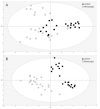Metabolomics analysis and modeling suggest a lysophosphocholines-PAF receptor interaction in fibromyalgia
- PMID: 25238064
- PMCID: PMC4169547
- DOI: 10.1371/journal.pone.0107626
Metabolomics analysis and modeling suggest a lysophosphocholines-PAF receptor interaction in fibromyalgia
Abstract
Fibromyalgia Syndrome (FMS) is a chronic disease characterized by widespread pain, and difficult to diagnose and treat. We analyzed the plasma metabolic profile of patients with FMS by using a metabolomics approach combining Liquid Chromatography-Quadrupole-Time Of Flight/Mass Spectrometry (LC-Q-TOF/MS) with multivariate statistical analysis, aiming to discriminate patients and controls. LC-Q-TOF/MS analysis of plasma (FMS patients: n = 22 and controls: n = 21) identified many lipid compounds, mainly lysophosphocholines (lysoPCs), phosphocholines and ceramides. Multivariate statistical analysis was performed to identify the discriminating metabolites. A protein docking and molecular dynamic (MD) study was then performed, using the most discriminating lysoPCs, to validate the binding to Platelet Activating Factor (1-alkyl-2-acetyl-sn-glycero-3-phosphocholine, PAF) Receptor (PAFr). Discriminating metabolites between FMS patients and controls were identified as 1-tetradecanoyl-sn-glycero-3-phosphocholine [PC(14:0/0:0)] and 1-hexadecanoyl-sn-glycero-3-phosphocholine [PC(16:0/0:0)]. MD and docking indicate that the ligands investigated have similar potentialities to activate the PAFr receptor. The application of a metabolomic approach discriminated FMS patients from controls, with an over-representation of PC(14:0/0:0) and PC(16:0/0:0) compounds in the metabolic profiles. These results and the modeling of metabolite-PAFr interaction, allowed us to hypothesize that lipids oxidative fragmentation might generate lysoPCs in abundance, that in turn will act as PAF-like bioactivators. Overall results suggest disease biomarkers and potential therapeutical targets for FMS.
Conflict of interest statement
Figures



Similar articles
-
The GC-MS metabolomics signature in patients with fibromyalgia syndrome directs to dysbiosis as an aspect contributing factor of FMS pathophysiology.Metabolomics. 2019 Mar 27;15(4):54. doi: 10.1007/s11306-019-1513-6. Metabolomics. 2019. PMID: 30919098
-
Activation and regulation of platelet-activating factor receptor: role of G(i) and G(q) in receptor-mediated chemotactic, cytotoxic, and cross-regulatory signals.J Immunol. 2006 Sep 1;177(5):3242-9. doi: 10.4049/jimmunol.177.5.3242. J Immunol. 2006. PMID: 16920964
-
Up-regulation of platelet-activating factor synthases and its receptor in spinal cord contribute to development of neuropathic pain following peripheral nerve injury.Mol Pain. 2012 Feb 2;8:8. doi: 10.1186/1744-8069-8-8. Mol Pain. 2012. PMID: 22296727 Free PMC article.
-
Platelet-activating factor receptor.Prostaglandins Other Lipid Mediat. 2002 Aug;68-69:599-609. doi: 10.1016/s0090-6980(02)00058-8. Prostaglandins Other Lipid Mediat. 2002. PMID: 12432946 Review.
-
PAF receptor and tumor growth.Curr Drug Targets. 2014;15(10):982-7. Curr Drug Targets. 2014. PMID: 25182608 Review.
Cited by
-
Oxidative stress involves phenotype modulation of morbid soreness symptoms in fibromyalgia.RMD Open. 2023 Mar;9(1):e002741. doi: 10.1136/rmdopen-2022-002741. RMD Open. 2023. PMID: 36918228 Free PMC article.
-
Novel 2-pheynlbenzofuran derivatives as selective butyrylcholinesterase inhibitors for Alzheimer's disease.Sci Rep. 2018 Mar 13;8(1):4424. doi: 10.1038/s41598-018-22747-2. Sci Rep. 2018. PMID: 29535344 Free PMC article.
-
Single-cell metabolomics profiling of somatosensory neurons in various stages of neuropathic pain.J Biol Chem. 2025 Mar;301(3):108309. doi: 10.1016/j.jbc.2025.108309. Epub 2025 Feb 13. J Biol Chem. 2025. PMID: 39955065 Free PMC article.
-
Metabolomics and Microbiomics: New Potential Strategies in Chronic Pain Syndrome.J Pain Res. 2022 Mar 11;15:723-731. doi: 10.2147/JPR.S354516. eCollection 2022. J Pain Res. 2022. PMID: 35310896 Free PMC article.
-
Discrimination and Nitric Oxide Inhibitory Activity Correlation of Ajwa Dates from Different Grades and Origin.Molecules. 2016 Oct 28;21(11):1423. doi: 10.3390/molecules21111423. Molecules. 2016. PMID: 27801841 Free PMC article.
References
-
- Wolfe F, Smythe HA, Yunus MB, Bennett RM, Bombardier C, et al. (1990) The American College of Rheumatology 1990 criteria for the classification of fibromyalgia. Report of the Multicenter Criteria Committee. Arthritis Rheum 33: 160–172. - PubMed
-
- Wolfe F, Clauw DJ, Fitzcharles MA, Goldenberg DL, Katz RS, et al. (2010) The American College of Rheumatology Preliminary Diagnostic Criteria for Fibromyalgia and Measurement of Symptom Severity. Arthritis Care Research 62: 600–610. - PubMed
-
- Altindag O, Celik H (2006) Total antioxidant capacity and the severity of the pain in patients with fibromyalgia. Redox Rep 11: 131–135. - PubMed
-
- Ozgocmen S, Ozyurt H, Sogut S, Akyol O, Ardicoglu O, et al. (2006) Antioxidant status, lipid peroxidation and nitric oxide in fibromyalgia: etiologic and therapeutic concerns. Rheumatol Int 26: 598–603. - PubMed
Publication types
MeSH terms
Substances
LinkOut - more resources
Full Text Sources
Other Literature Sources
Medical
Miscellaneous

